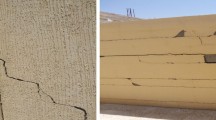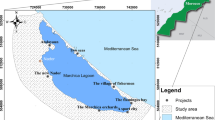Abstract
The sub-environnements in the coastal region of Nigeria consisting of meander belt, fresh water and backswamp deposits, mangröve swamps, beach ridge bars and estuaries are underlain by a complex stratigraphical succession of soft silty clay, sand and gravels. The unpredictable stratigraphical succession is complicated by the prevalence of soft and thinly bedded strata which are hardly detected during soil exploration. These thin soft beds introduce inaccuracies on settlement computation and create difficulty in foundation design which frequently lead to unsatisfactory performance. Although some heavy structures can be founded within the sandy formation, occurring on the top layers the stresses induced by such structures can result in indesirable and large total consolidation settlement of the underlying compressible layers. Sensitive structures need therefore be founded on piles, driven to lepths where either sufficient shaft or end-point resistance can be mobilized to ensure satisfactory performance. Strip or raft foundations can easily support structures like bungalows and one storey buildings within the coastal plain sand-and-beach-ridge sub-environments. Ground improvement is generally required in mangrove swamp, meander belt and within the Sombreiro-Warri-deltaic sediments, even for simple structures.
Résumé
La région côtière du Nigéria est composée de meandres fluviatiles, de dépôts marécageux, de mangrove, de plages, de barres et d'estuaires, et a pour sous-sol une succession stratigraphique complexe d'argile molle et vaseuse, de sables et de graviers. La stratigraphie complexe est encore compliquée par de fines couches molles qui sont a peine détectables lors de l'exploration du sol. Ces fines couches molles provoquent des erreurs dans l'évaluation des couches sédimentaires et créet des difficultés dans la conception des fondations conduisant fréquemment à des performances non satisfaisantes de ces dernières. Bien que certaines structures lourdes puissent être fondées sur la formation sableuse se trouvant dans les couches supérieures, les pressions créées par ces ructures peuvent provoquer un tassement des couches compressibles sous-jacentes. Ces structures doivent donc être fondées sur des pieux enfoncés a des ofondeurs où une résistance suffisante peut être obtenue pour assurer une performance satisfaisante. es fondations superficielles peuvent facilement supporter des structures comme des villas et des maisons à un étage dans les zones de sable et de plages de plaine côtière. L'amélioration du sol est généralement nécessaire dans les mangroves, les méandres et dans les sédiments deltaiques, même pour des ouctures simples.
Similar content being viewed by others
References
ABAM T.K.S. and OKOGBUE C.O., 1993: Utilization of marginal lands for construction in the Niger Delta. Bull. of the Int. Association of Engr. Geology No. 48, pp 5–14.
ASSEZZ L.O., 1974: Review of the stratigraphic, sedimentation and structure of Niger Delta: In Kogbe ed. Geology of Nigeria, pp. 259–272.
BERGDAHL U., 1979: Development of the Dynamic Probing Method. Proceedings of the Seventh European Conference on Soil Mechanics and Foundation Engineering, Vol. 2, September, pp. 201–208.
dE COURT L., 1982: Prediction of the Bearing Capacity of Piles Based Exclusively on N-values of the SPT. Proceedings of the Second European Symposium on Penetration Testing. Vol. 1, May, pp. 29–34.
ENOCH GEORGE ASSOCIATES, 1990: Soil Investigations Reports from selected locations of the Niger Delta.
GEORGE E.A.J. and ABAM T.K.S., 1990: Soil Exploration strategies in the Niger Delta Region of Nigeria: Proceedings of the International Conference on Construction on Polluted and Marginal Lands, 1990, July, pp. 33–40.
JAGO C.F., 1974: The sedimentology of estuarine and coastal plain deposits between Endione and Wharley Point: Carmarthan Bay. Ph. D. Thesis, University of London
SHORT K.C. and STAUBLE A.J. 1967: Outline of the Geology of Niger Delta AAPG Vol. 51, pp. 761–779.
TOMLINSON B, 1987: Pile Design and Construction Practice, Low Price Edition, Viewpoint Publication, London, 378 pages.
WHITEMAN A., 1982: Nigeria, Its Petrolum Geology, Resources and Potential, p. 166, Vol. 12, Graham and Trotman, London
Author information
Authors and Affiliations
Rights and permissions
About this article
Cite this article
Bam, T.K.S. N soil exploration and foundations in the recent coastal areas of Nigeria. Bulletin of the International Association of Engineering Geology 53, 3–9 (1996). https://doi.org/10.1007/BF02594935
Published:
Issue Date:
DOI: https://doi.org/10.1007/BF02594935




